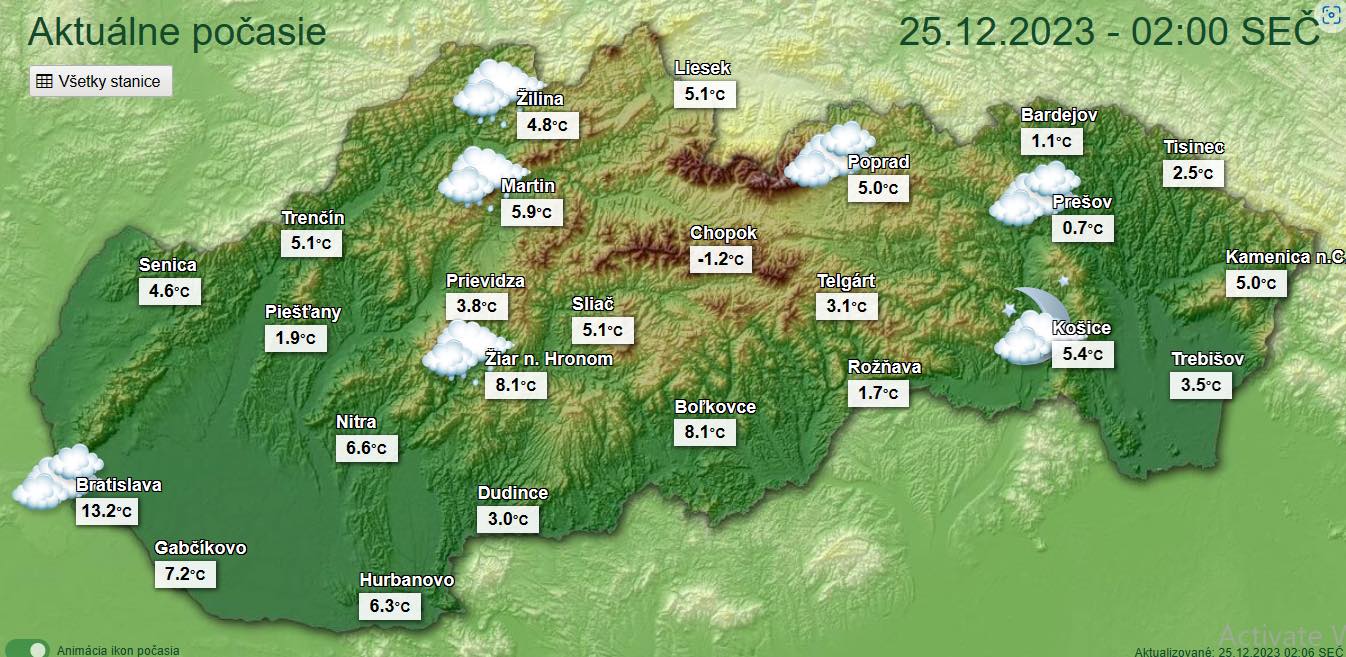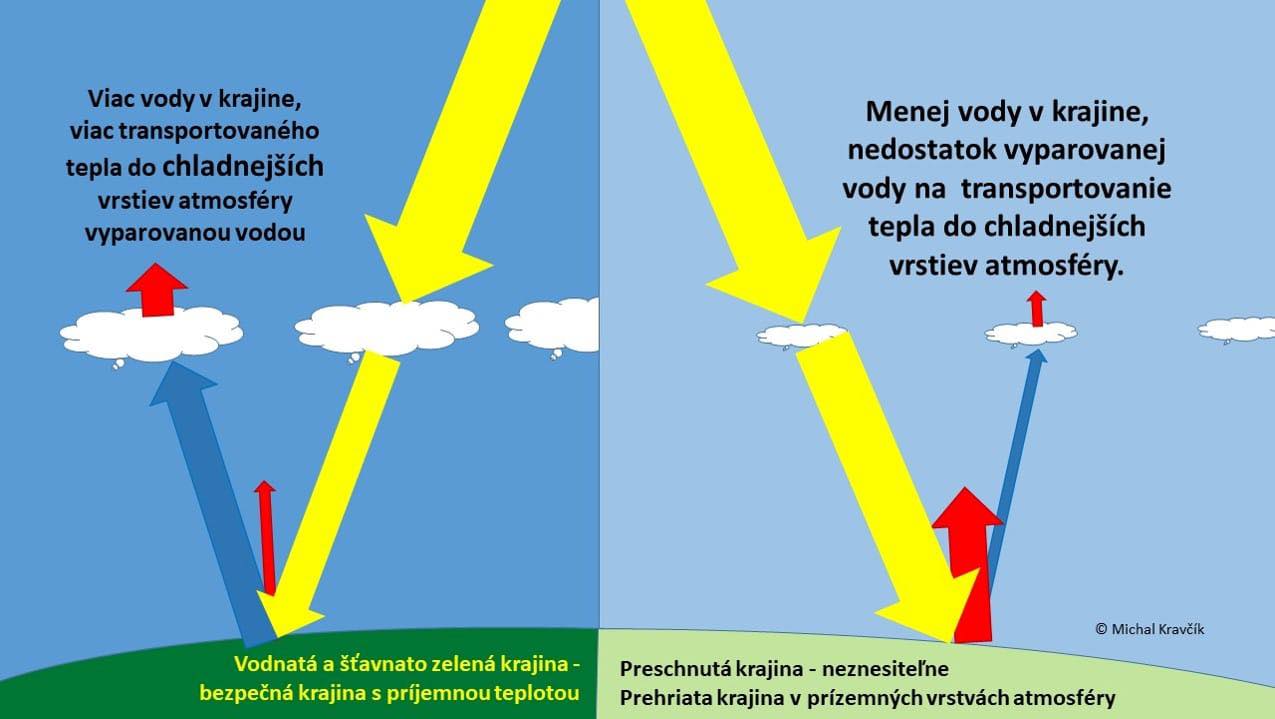What is the cause of the current extreme temperatures in Europe? Why do towns get dry spells or get flooded instead of receiving fluffy snow? I will attempt to explain the case of Bratislava, the capital of Slovakia, nestled on the Danube and Morava rivers at the foot of the Low Carpathian mountains. When I came out of midnight mass in Košice, it was obviously warmer than when I entered the church at midnight. The increase was about 3 degrees (See a map of temperatures in Slovakia by the Slovak Hydrometeorological Institute at 2 a.m.).
Records were falling, especially in Bratislava. The temperature rapidly rose to 14 degrees Celsius at night. You can see on the map that at 2 o’clock after midnight, it was over 13 degrees. Why is it possible that shortly after winter solstice, night temperatures reach spring or autumn temperatures? I have read the explanation given by climate scientists regarding the recorded rise in temperatures, but I am still searching for the root cause behind it. My question is whether our current knowledge is advanced enough to rationally explain the origin of this abnormality, considering the existence of numerous other anomalies.

Around the globe, we can see headlines such as:
- Dreaming of a white Christmas? It’s more likely to be brown!
- Santa says no white Christmas. Cloudy skies and mild temps stick around through the holiday. We’re in the middle of a record stretch without an inch of snowfall in NYC; Monday marks day 680.
- Severe floods hit Europe. Inhabitants evacuate their homes on Christmas Day
I want to offer an explanation that arises from the principles of the New Water Paradigm. This also explains the unusual weather patterns currently being observed in Central Europe. It’s important to note that traditional climatology has yet to provide a clear explanation for such phenomena. Weather reports often mention extreme statistics for climate change without providing any insight into the causes behind them. As you may recall, some forecasts at the end of autumn predicted a harsh winter. Other forecasts talked about possible El Niňo effect continuing into 2024. Yet, our grandparents in Central Europe always experienced snowfall. Although the amount of snowfall varied each year, the farmer’s almanac and their crops could rely on it.
What are the New Water Paradigm principles, as stated in our 2007 paper? When we damage and dry out ecosystems, we empty small water cycles – that rainfed soil moisture feedback loop that allows nature to “breathe” to evaporate and transpire water and return it back to earth. That perpetuum mobile, the water cycle, keeps all life alive on our planet. Over the past 60 years, we have completely dried out, grubbed, and developed, then urbanized an incredibly vast area – millions of square kilometers. They account for almost 20 million km2 (13% of the continents). I want to remind you that the damaged urbanized areas do not include extensive industrialization of agricultural landscapes, their drainage, regulation of streams and rivers, or drying of wetlands.
All these influences wreck havoc in our watersheds, as we dried out the small water cycles . According to our estimate, based on research from Slovakia, we are working on the fact that continents are deprived of about 760 billion m3 every year. Such permanent water loss from small water cycle evapotranspiration feedback loop on the continents has also caused an increase of about 45 billion m3 in the oceans over 60 years. What does this mean for rising ocean levels? A rise “only” by 12 cm. This is about water balance. But what does this have to do with the weather?
So, let’s repeat at least 2 laws of physics. The first is the law of conservation of energy, which is directly related to it, and the second is the 2nd thermodynamic theorem.
Let’s review the law of conservation of energy. It follows that the energy that comes from the Sun is not lost but is transformed into at least 2 types of heat: latent heat (energy is consumed on evaporation) and sensible heat (solar radiation is not consumed on evaporation, then it turns into sensible heat or perceptible heat that we feel).
Historically, as long as our ecosystems had enough water in the landscapes (such as soil moisture, wetlands, and vibrant biodiversity habitats), water evaporation and plant transpiration absorbed solar energy. If we consider the state of water 60 years ago, there were 45,000 billion m3 more water on the continents.
Regular energy transfer by photosynthesis converts water into vapor, and healthy watersheds needed 31.5 million TWh to evaporate 45,000 billion m3 of water in 1960. Due to decreased vegetation and lack of porous surfaces, urban areas are left to cope with the excess solar energy, which amounts to 31.5 million TWh that warms our new human habitats. To put this into perspective, our global annual energy consumption is less than 200 thousand TWh. This means that the Earth’s troposphere has warmed as much in the last 60 years as it did in approximately the previous 160 years. This energy was transported in the past as the latent heat by evaporation to the colder layers of the atmosphere, so it did not wreak havoc in the troposphere. In the colder layers of the atmosphere, rain forms at the dew point and falls down, recycling moisture. Thus, latent heat is transformed according to the law of conservation of energy.
As a result of damaging and dehydrating the landscapes, we have caused the continents to dry up. Consequently, the water that flows into the ocean is no longer available to absorb solar radiation and transfer it from land. This radiation, when it reaches the earth’s surface, converts into heat, which contributes to the overheating of the troposphere. This is known as the law of conservation of energy. It’s a fundamental principle of physics that helps us understand how energy behaves in various systems.
Now we get to an answer to why such anomalies arise when several warm waves occur during the winter. These warm waves cause chaos in the atmosphere and pose a risk of flooding, as well as destabilizing the weather in Slovakia, and other countries.
According to the second law of thermodynamics, heat naturally flows from warmer objects to cooler ones. However, our current land usage practices tend to exacerbate this flow by depleting natural resources and drying out agricultural landscapes.
People do not damage ecosystem so aggresively in colder regions such as mountains, forests, and nature preserves. The transformation of land use and land cover causes the formation of heat islands that emit warm air towards colder regions, following the 2nd law of thermodynamics. People are responsible for creating these heat islands, which include the entire Sahara desert. These heat islands are gradually expanding northward into Europe through the Mediterranean countries, causing significant temperature changes. Then, we can observe further outcomes of the unpredictable climate. This year on Christmas Eve, some areas in Germany had to evacuate their residents due to unprecedented flooding caused by heavy rainfall.
It is all about climate stability.
It is worth noting that the region around the Arctic Circle experiences the most frequent and noticeable temperature changes, but that will be a topic of a separate review.
So, what is the prognosis of the romantic “white Christmas just like the one I used to know?”.
The laws of physics suggest that all ski resorts, insurance companies, and snow gear retail shops should take notice. Journalists should provide more detailed information on the main causes of these dry spells and also keep an eye out for potential flooding. If we want future generations to enjoy snowflakes like we did, we need to take action, starting from our own backyards.
Furthermore, the true essence of Christmas has never been about the romanticized sentiment often affiliated with it. Rather, it’s a time when people introspect and reflect on their connection to others. As human beings, we are all intertwined with nature in a complex web of relationships and interdependencies. Christmas is an encounter.
Author: Michal Kravčík
Editor: Zuzka Mulkerin
[1] New water paradigm (2007), www.waterparadigm.org
WATERHOLISTIC, Košice, Slovakia

